Jewel orchids have really soared in popularity over the last 2 years + it’s pretty easy to see why. More + more varieties have entered the houseplant market in 2020 + the rarer types frequently sell out within days. I remember falling for them at a festive pop up… when I saw how popular they were — there was a swarm of people admiring my display of Ludisia discolor + when I sold nearly two shelves in one day I thought I’d better see what the fuss was about… so I bought one as a present to myself! I’d say that the Ludisia is generally considered the most ‘common’ variety of jewel orchid available at the moment, despite being pretty elusive a few years ago.
That dark, brooding foliage completely transforms into a veritable disco ball of sparkle when the sunshine hits those lovely leaves + that’s not even mentioning their statuesque blooms.
This has been a highly requested post so I hope you find this care guide helpful. These plants are often labelled as ‘easy care’ but from the amount of questions I receive about looking after them, I’d say this is a bit of a vague + subjective categorisation. This is because this is a very different beast in relation to other types of orchid + compared to other houseplants it has slightly different needs. I’ve had my plant for 2 years + I can agree that it’s a bit of a learning curve if you are not accustomed to their likes + dislikes.
In this post I have used my two types of jewel orchid — Macodes petola + Ludisia discolor to give a full care guide to keeping these plants happy in your home.
I will be going into the topics of:
- light
- watering
- humidity
- fertilising
- pests
- flowering
- temperature
- propagation
- potting mix
- + repotting
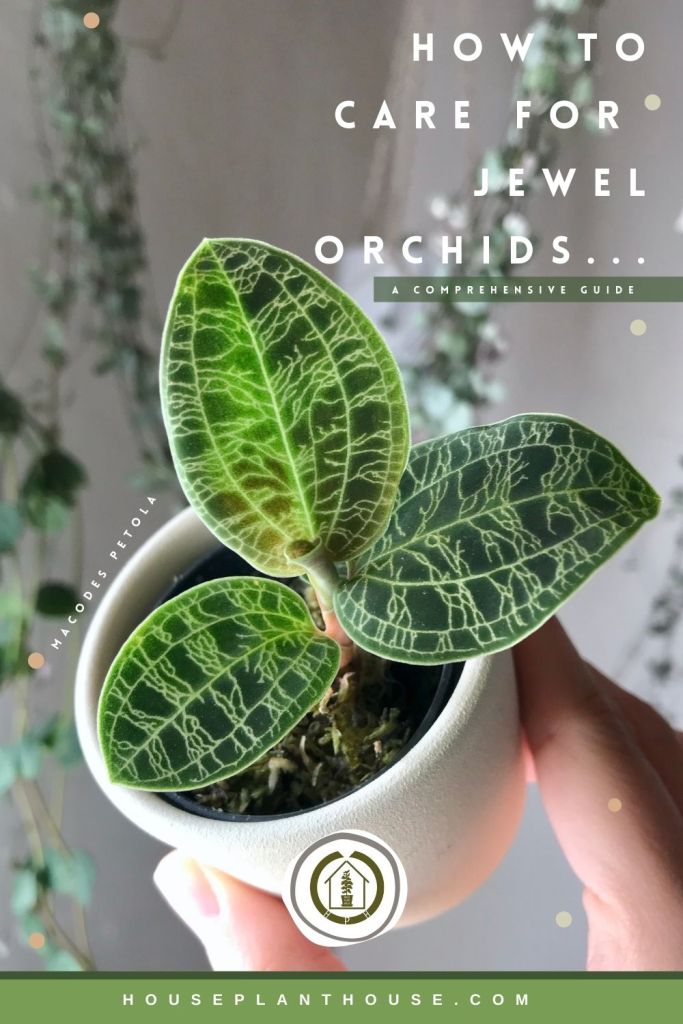
Light
Jewel orchids are quite adaptable to a range of locations, from fairly bright (but importantly) indirect light to somewhere a little more shady. This is because they are used to growing along the rainforest floors in their natural habitat of South East Asia. When understanding the care needs of any plant, it’s always good to look into how + where they grow in their native habitat. I have found that Ludisia can cope better in lower light than the Macodes. In my experience, the Macodes has more of a tendency to stretch a bit if it is looking for light so if you find the stems are getting etiolated with larger gaps between the leaves on the stem, moving it to a brighter position is a good idea.
Alternatively, if your plant is getting too much light you will likely notice yellowing, scorched leaves. Be mindful of the light intensity as the seasons change as you might find that moving your plant closer to a window over winter + further away in Summer is necessary depending on your specific conditions. I keep both my Ludisia + Macodes close to a north west window most of the year (I’m in the Northern hemisphere) but during Summer I moved them further away when the light was more intense. Bear in mind that these are the conditions that are personal to my current environment + are used as a guide for you to compare with your own home. It’s important to also remember that windows can be pretty different in size + if you live in a built up area, with other buildings close by, or if there are obstacles like trees outside, this all has an impact on the intensity of light.
Jewel orchids also respond really well to grow lights so I tend to give mine a few hours with a lamp when it’s quite dark.
Watering
As you might expect, these plants enjoy moist conditions to really thrive. They are often kept in smallish pots + I like to wait until the top third of the pot has dried out before watering again. I also try to avoid getting water on the foliage as this can cause mildew.
The most important aspect of watering concerns water temperature — tepid (room temperature) water is always best but especially with these plants. I mentioned this over on instagram last week because cold water, particularly in the colder months of the year can really shock your plants + stress them out unnecessarily. If the plant is in bloom, it’s particularly important not to use very cold water. If you are new to keeping houseplants this might be something you didn’t know + can be a bit of a ‘rookie error’. If you use tap water, it’s a good idea to let the water sit for a day or so before using it. I tend to make up a few watering cans + leave them on my shelf for around 36 hours if I know I have watering to do.
There are two watering methods that work for jewel orchids + I use a combination of both to keep my plants looking their best. The first method is to place the nursery pot in a sink (removing any cache pot) + flush water through until it runs out of the bottom of the pot. I’ll leave the pot to sit here for 20 mins or so so that any excess water has properly drained away before putting it back in the planter.
The other method concerns using my trusty watering plate + watering from the bottom. I put my pots on a large flat plate or drip tray + water the plate, before leaving the pots on there for around 30 minutes to an hour. On average, I tend to do this every 2-3 waterings, then give the plant a flush through the next time.
Don’t let the soil completely dry out as this can lead to drying or wrinkled leaves, + dropping flowers. Over-watering will also cause blooms to fail + yellowing leaves too. Root rot is a very real issue with these plants caused by prolonged overwatering + can be fatal. If you have your nursery pot inside a cache pot, make sure you don’t leave the jewel orchid sitting in water so remove before watering.
You will notice that with increased humidity, watering will be less frequent — more on this next!
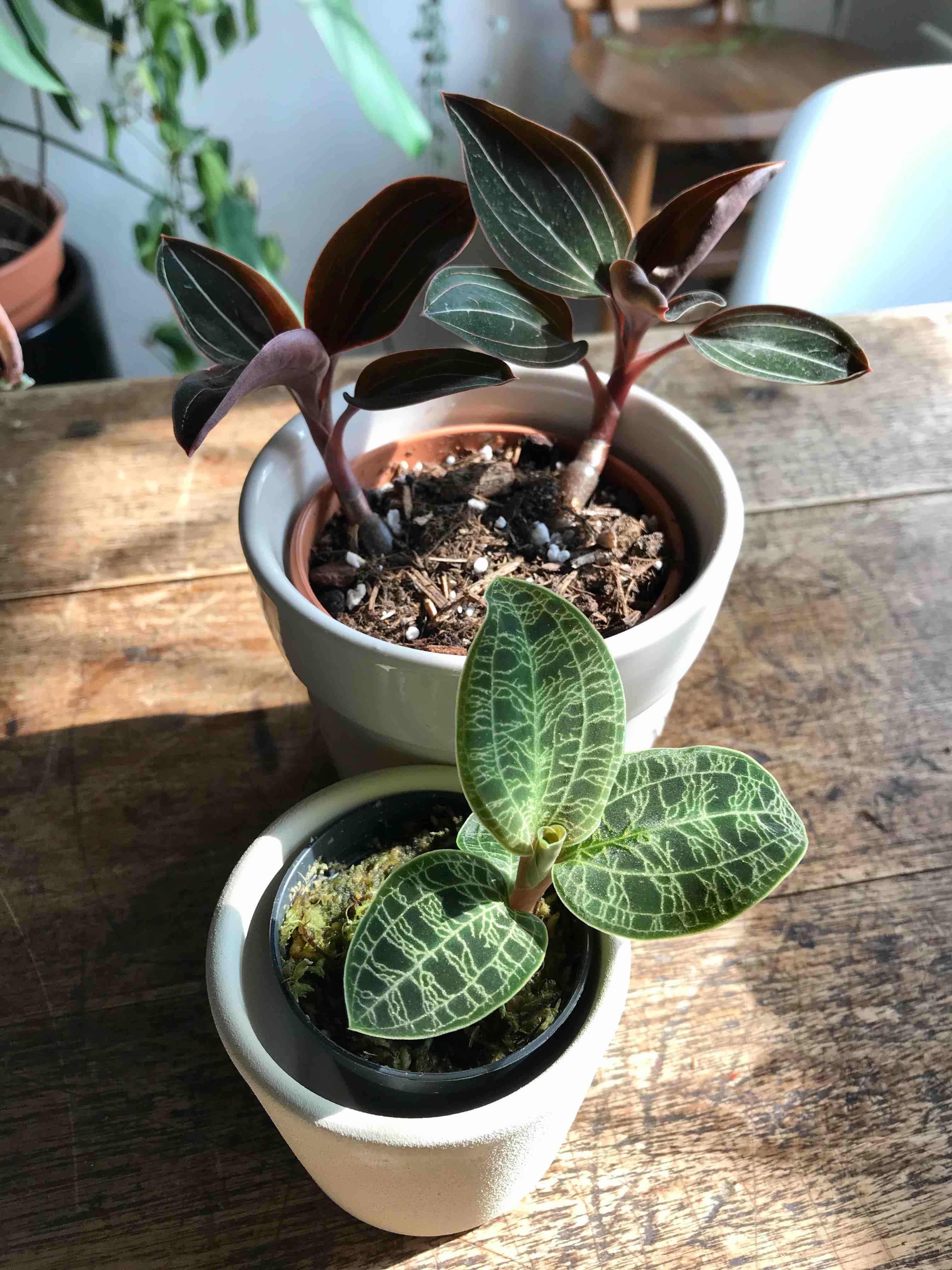
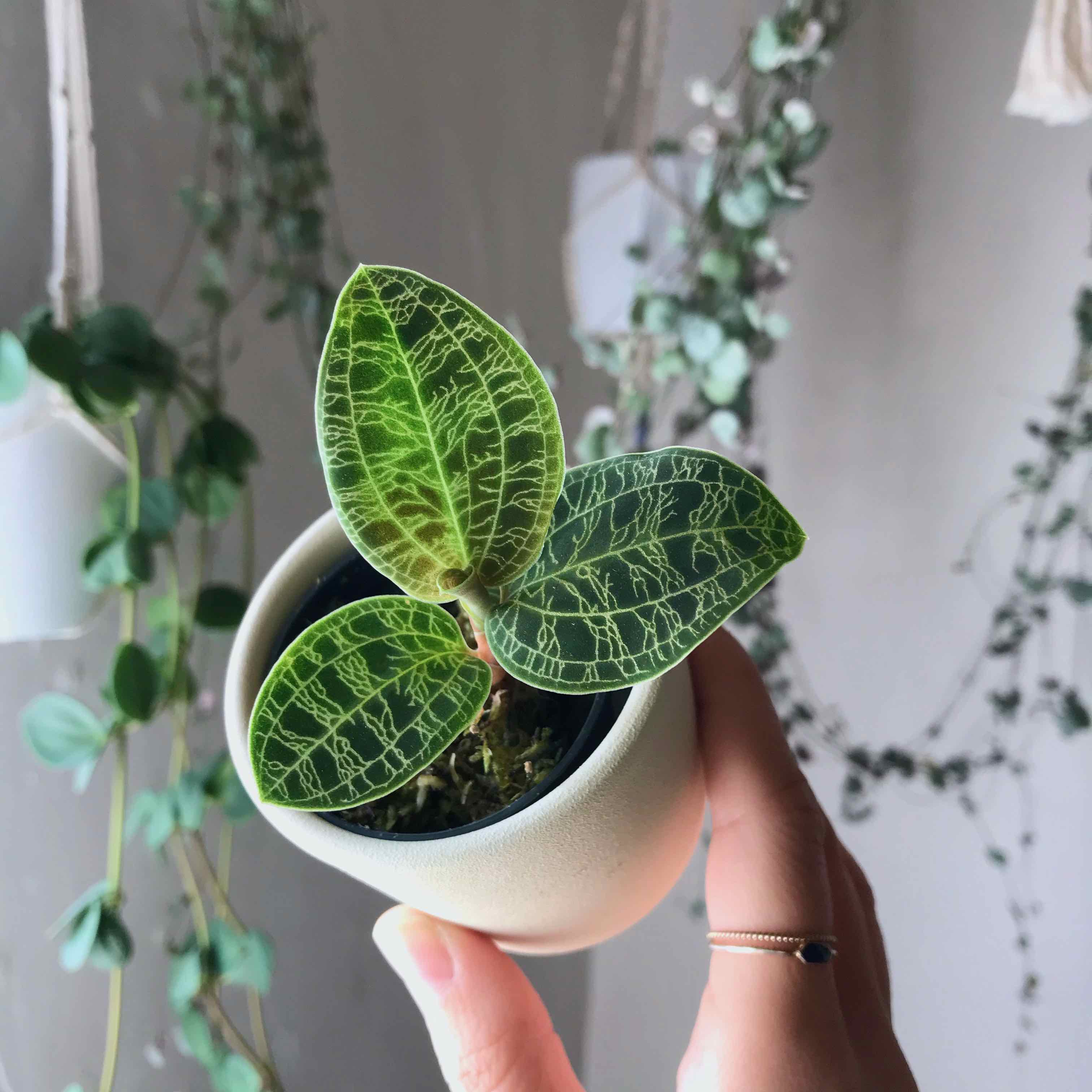
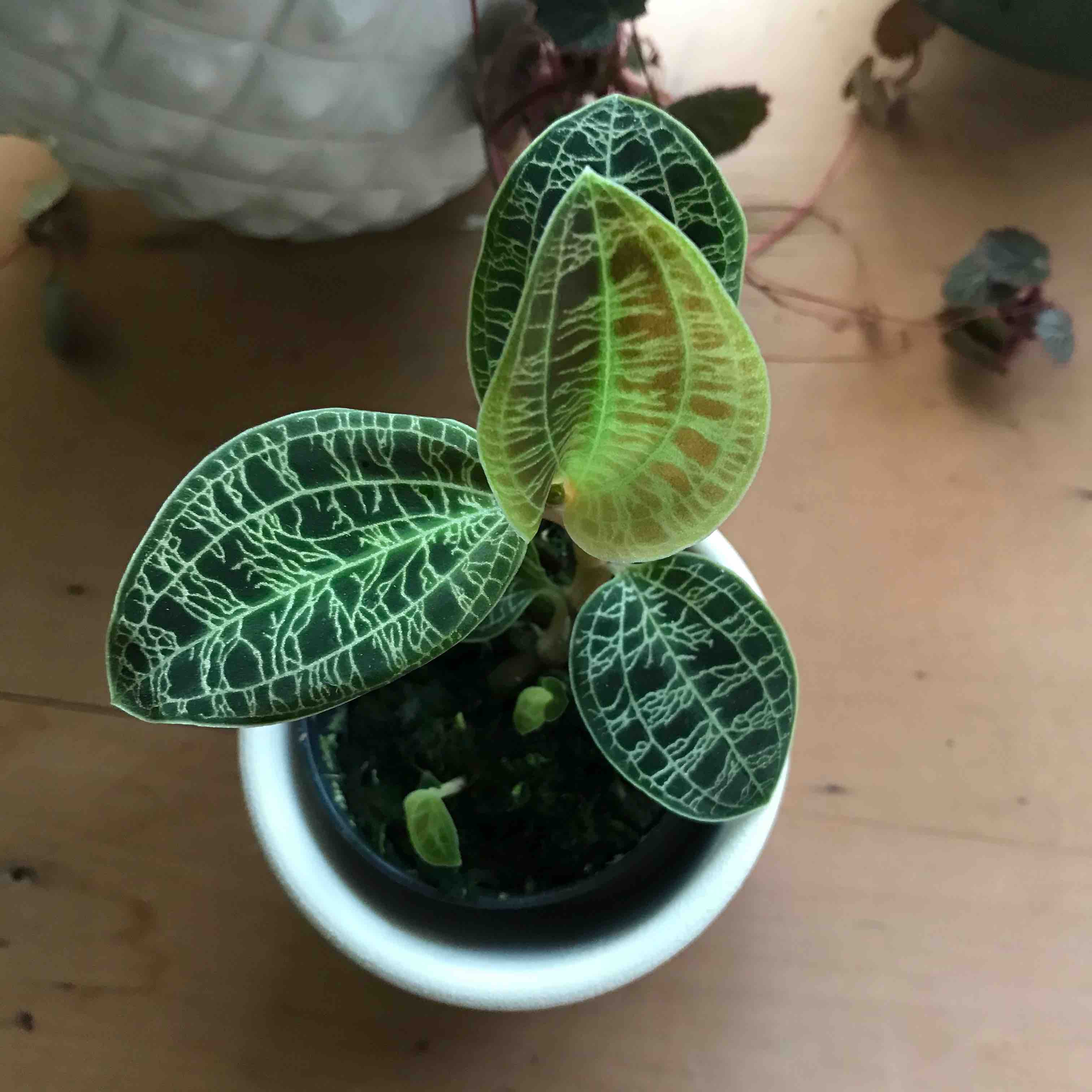
Humidity
This is where things differ — Ludisia discolor can cope well with average household humidity without the need for any special requirements. Macodes petola however prefers more humid conditions to thrive. Increased humidity can create larger foliage + growth might be slightly quicker as a result. As much as jewel orchids appreciate average-high humidity, you should ensure there is adequate air circulation otherwise mildew can appear on the leaves. When watering, avoiding getting the foliage wet can reduce the risk of this happening considerably.
Due to their humidity requirements, these plants make great choices for growing in a terrarium or under a cloche. With increased humidity, the watering needs will be reduced + remember that in a closed situation like a cloche, you might even not need to water at all. I keep my macodes under a glass dome + haven’t needed to water it over the last 6 weeks.
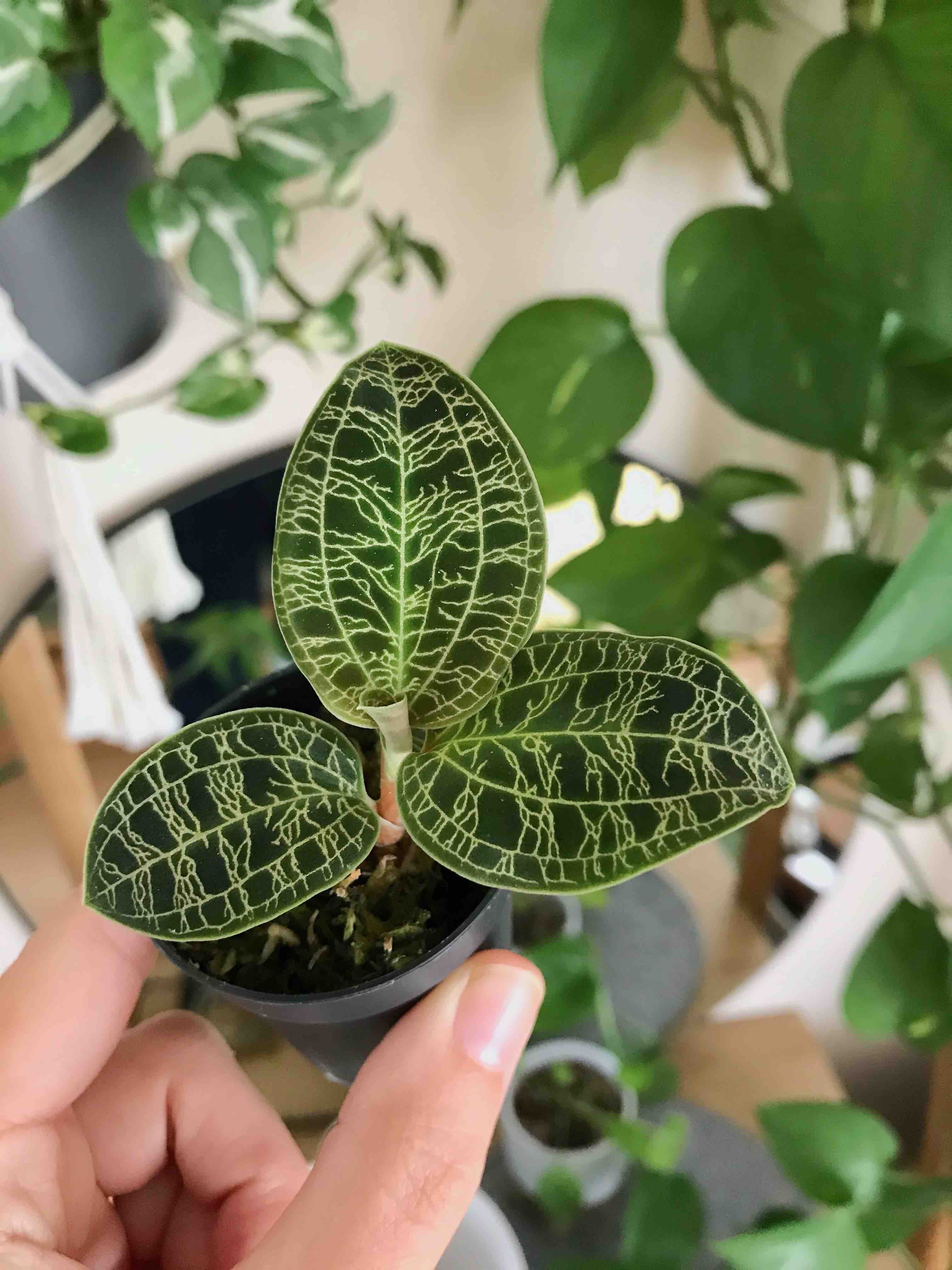
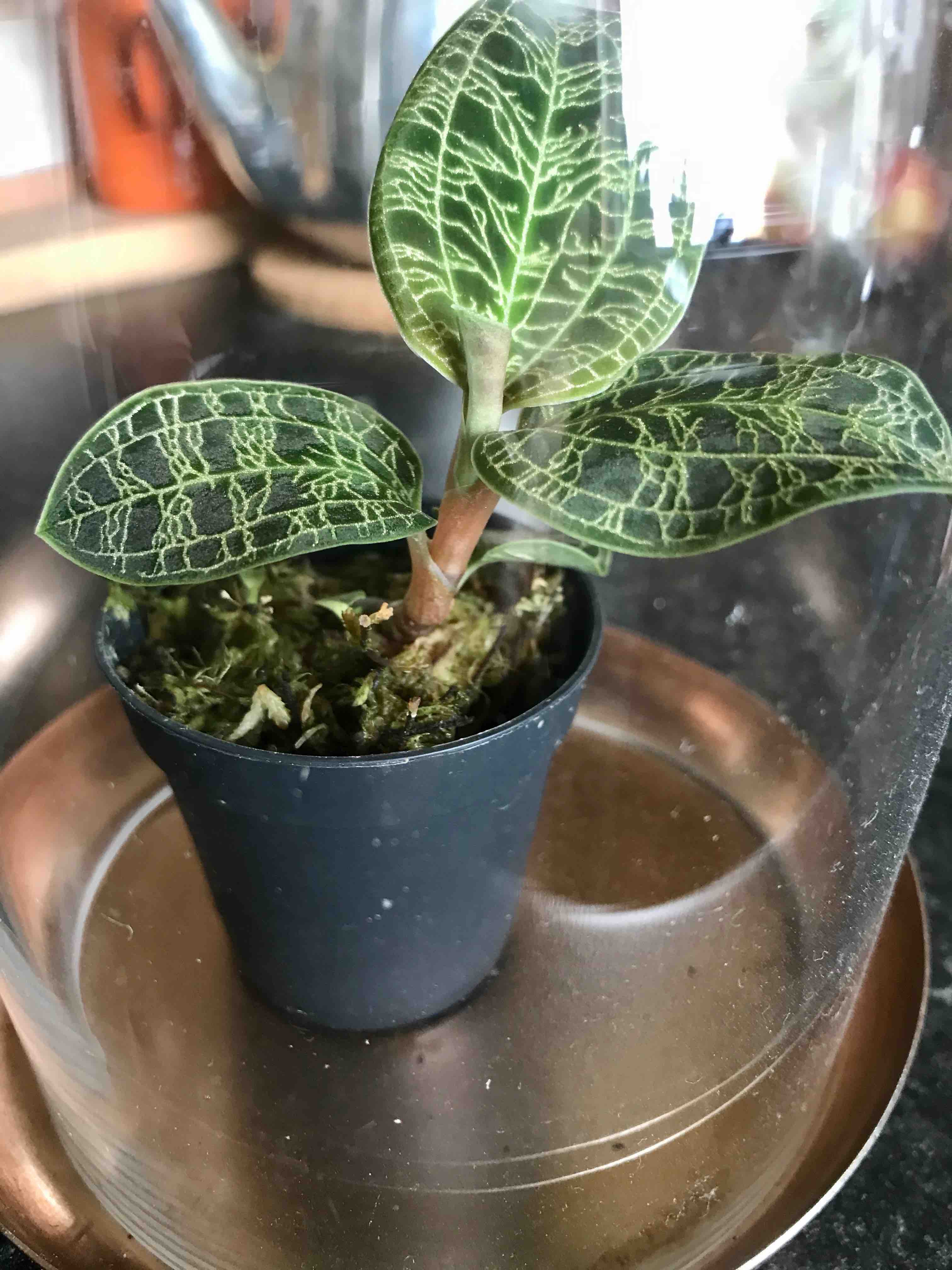
Fertilising
Jewel orchids are slow growers so fertilising once a month is adequate during spring + summer using a regular houseplant fertiliser. As an additional point, in terms of the frequency of feeding, if your climate is quite different to mine + you find your plants grow year-round, then more regular fertilising is fine. It’s very cold where I live between December + February + with the harsh decrease in temperatures + I’m getting used to my houseplants stopping growing altogether in this time. When your plant is starting to produce flowers (which is often over winter), you can choose to temporarily re-commence fertilising with your regular feed or preferably with a potassium (K) rich feed (like tomato feed) at the sight of the first flower spike(s). This is not essential but it can help prolong the duration of the flowering period. I always use feed at half the recommended dilution rate with my houseplants.
Pests
The most common pest issues you might encounter with jewel orchids are mealy bugs. Look out for white cotton-wool like clusters or small white bugs on the undersides of leaves + around the crevices of new leaves or densely entangled stems. Other potential pests include scale, spider mites or thrips. Have a look at my pest posts about how to deal with these issues in greater detail. A Q-tip soaked in rubbing alcohol will treat a minor attack of a few lone bugs, but something larger in scale will require more extreme measures such as a neem oil/insecticidal mix, a soil change, or pruning. After any treatment, I like to use SB plant invigorator either as a ready to use spray, or you can also get a concentrated bottle to dilute into a spray bottle yourself.
It’s good practice to always isolate any new plants you bring into your home for a few weeks + similarly, quarantine any plants suffering with pests. Prevention is better than cure, so by focusing on understanding the needs of your plants, you can help reduce the likelihood of major pest issues. Very low humidities + warm dry conditions coupled with incorrect watering can weaken the plant + make it much more susceptible.
Flowering

These orchids are winter bloomers + my Ludisia generally flowers annually around Christmas which makes for a lovely coffee table display! Unlike the ever popular Phalaenopsis + other epiphytic orchids, jewels orchids are largely grown for their foliage over their flowers, but I must say, I really like them! When mine was blooming I was completely fascinated by their unique texture + took lots of photos!
Here’s my main plant flowering last December. Macodes petola doesn’t flower quite as readily but this is partly due to its slower growth habit than Ludisia discolor + the fact that as they are less common, these comparatively smaller plants take longer to reach the maturity that generally causes the plant to bloom. It sounds a bit mean but causing your plant a bit of stress can encourage flowers to appear. Keeping your plant pot-bound is one way, which I do anyway (they don’t like being repotted) as does reducing watering + keeping the plant in a cooler position at night. In terrarium conditions, be aware the plants are less likely to produce long lasting blooms as the moist conditions can cause the flower spikes to spoil.
If you aren’t fussed about flowers, you can choose to pinch out the spikes as they appear because their growth does divert energy away from the plant. After a flowering period, you might find the the plant becomes a bit leggy which is another reason you might choose to remove the flowers.
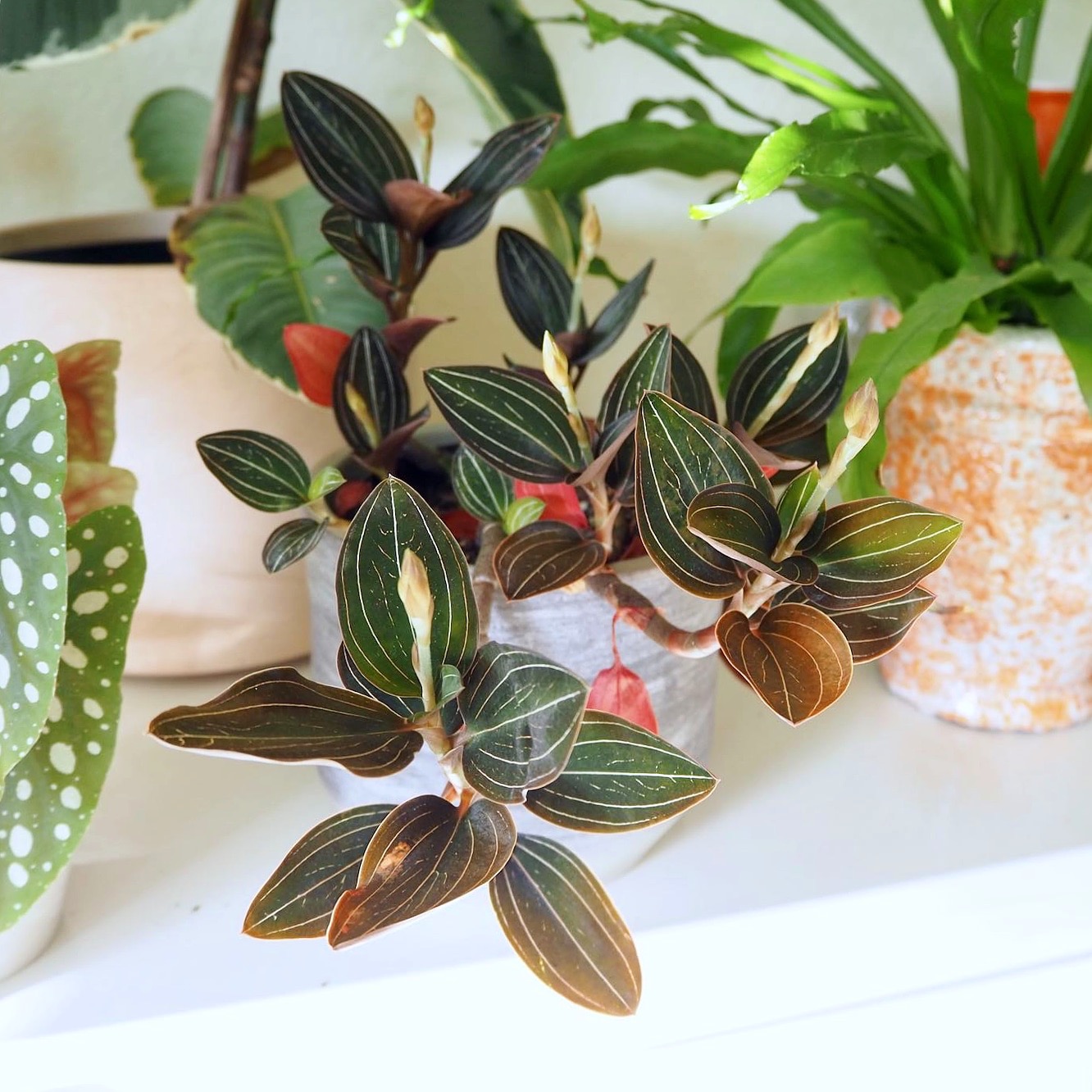

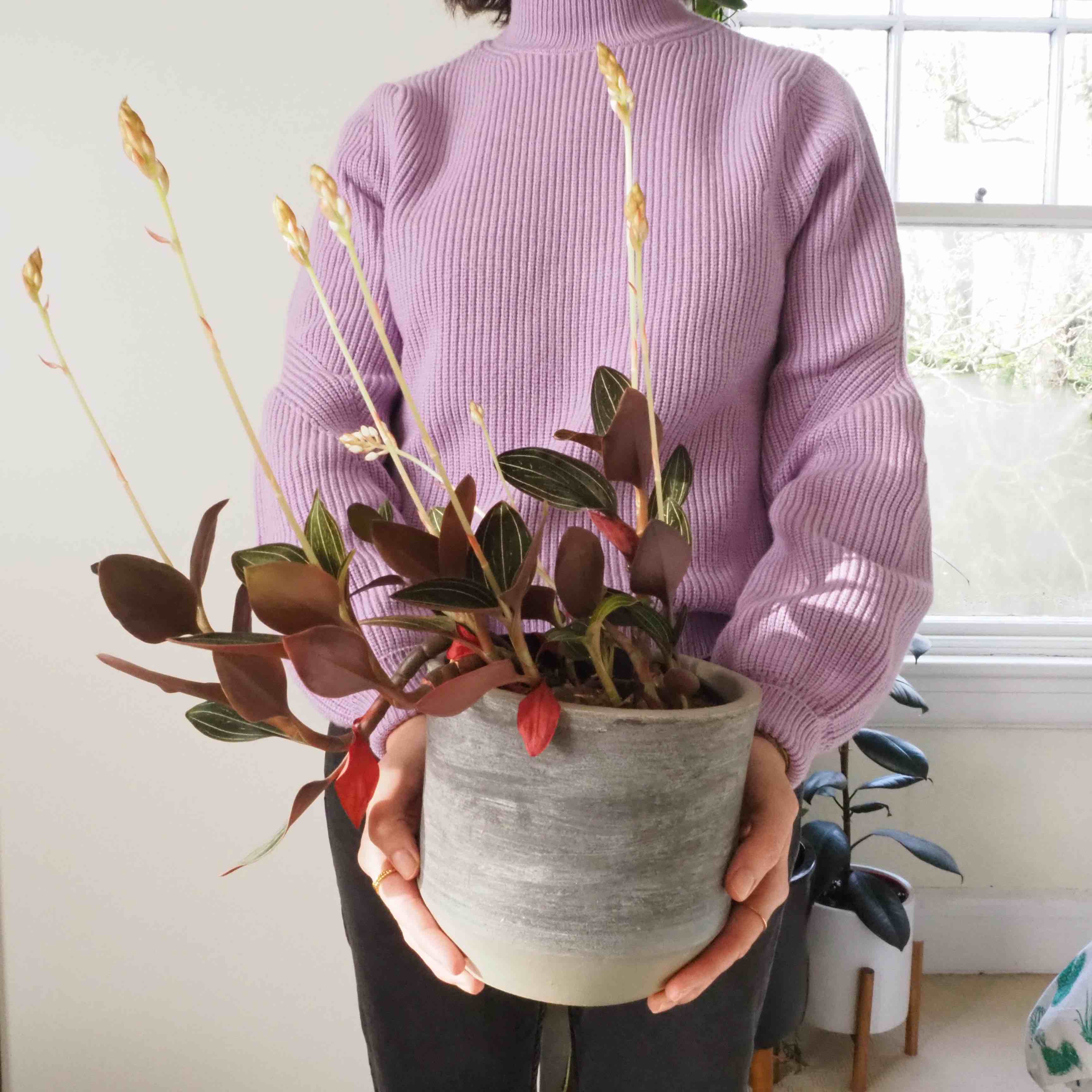
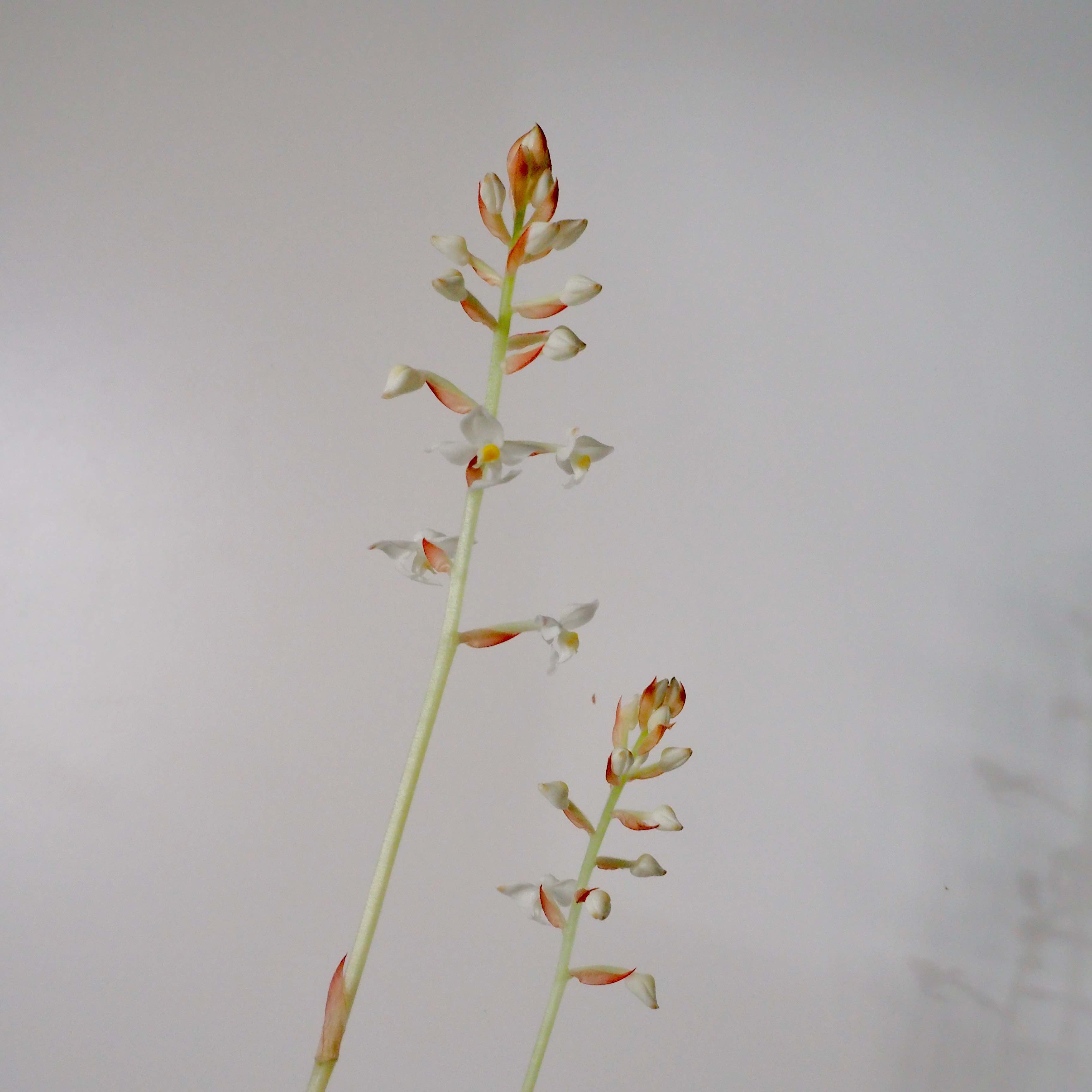
Temperature
If you also keep other types of orchids, you’ll have some experience of the importance of temperature in their plant care needs. I’d say this is how their care differs from other ‘regular’ houseplants, which prefer more consistent temperatures without regular fluctuation. Jewel orchids like warmer (more tropical) temperatures that are greater than 15°C (59°F) — daytime temperatures of between 16°C (61°F) + 25°C (78°F) are ideal + they like a decrease in both light + temperature at night. It is these cooler nights that can help to promote flowering. Like all houseplants, don’t place near draughts or a heat source such as a radiator as your plant will be very unhappy indeed! Be aware that temperatures lower than 10°C (50°F) can cause some damage to your plant + avoid frosts at all costs as this will result in plant collapse.
Propagation
Ludisia discolour can look a bit ‘messy’ as it matures due to its lateral growth habit which is rhizomatic in nature. Fortunately, jewel orchids can be propagated easily by division but can also be propagated by seed too.
To take a cutting, choose a stem where there are a cluster of leaves + chop a few centimetres below that point. Be sure to use a sterile blade to do this to risk causing any infection to the plant, or contamination from other plant care (+ always clean the blade after use!). In the photo below left you can see an example of a cutting. You can put in potting mix, water it in + the cutting will generally root successfully. If you have a way of increasing the humidity whilst the cutting is rooting (use a pebble tray perhaps, or a clear bag, or cloche) this can help speed the process up. I accidentally snapped a stem of my more mature Ludisia + let it callus for a few days on a tray before popping it in a glass bottle with some water + sort of forgot about it. To my surprise it flowered whilst in the water too — it was still in sync with the mother plant!
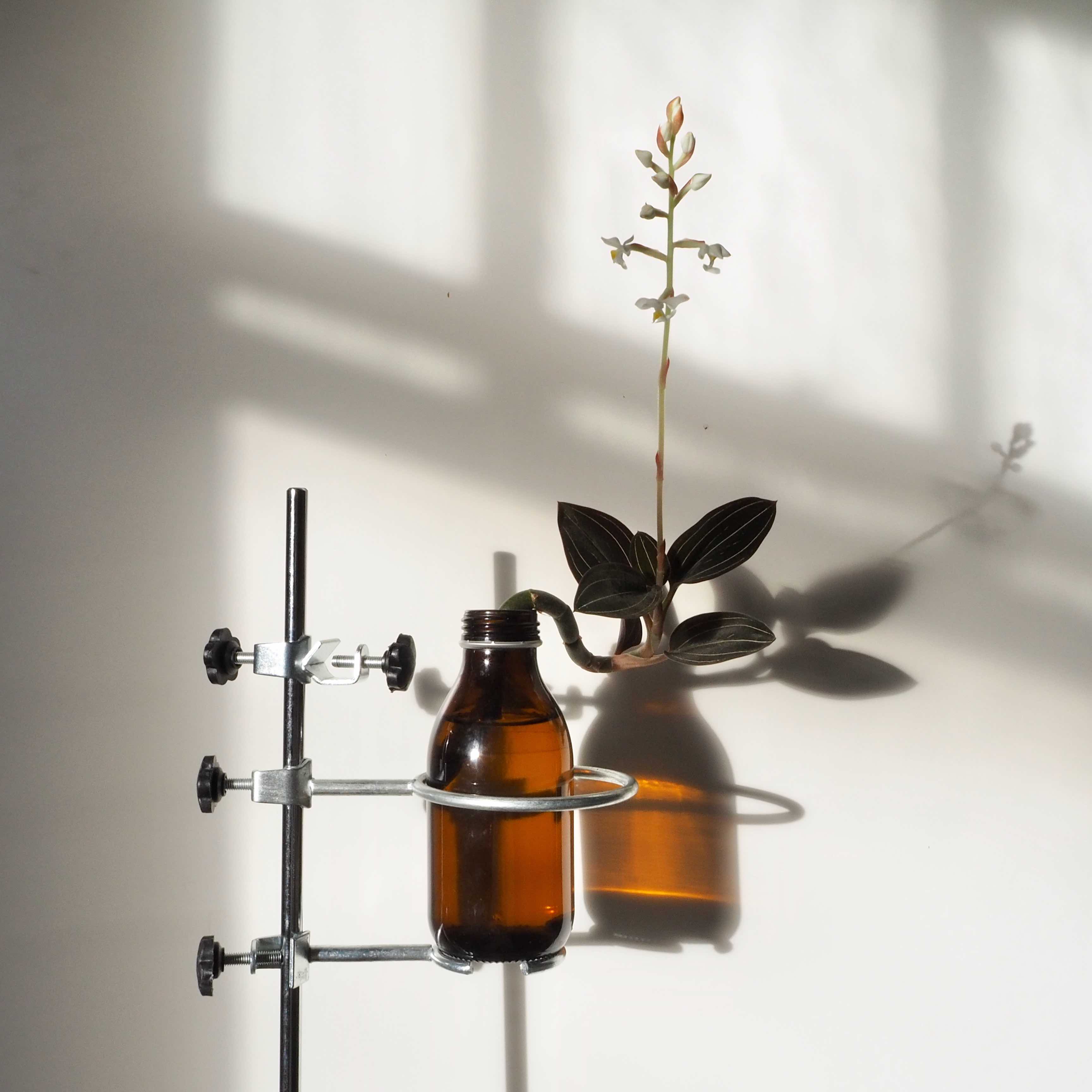

Potting Mix
Jewel orchids don’t require special orchid potting mix like the other more common epiphytic types. There are a number of ‘blends’ that can work, but my potting mix of choice is something light + airy that allows aeration to the roots + avoid using a very dense substrate to help to reduce the possibility of root rot. For my Ludisia, that’s currently a mix of houseplant potting compost, chunky coco coir, perlite + horticultural grit. Here is the link to my general houseplant potting mix I will tweak to suit the plants I am re-potting. I will often add some sphagnum moss into the mix too, or also add a layer to the top of the pot to help keep the moisture in + the soil temperature up. This is a good tip if you are prone to under-watering! I’ve actually got my macodes in straight up sphagnum moss at the moment because I haven’t had it very long + I generally like to wait a while before repotting anything. It also fits nicely in my cloche as it is, so for now it’s staying like this! It’s been growing really well + I’ll definitely think about which of my other houseplants might benefit from a bit of sphag. If you are using this substrate please make sure you buy your Sphagnum from a reputable source.
Repotting
Terrestrial orchids don’t have a large root structure (partly due to their rhizomatic growth habit) + are therefore usually kept in relatively small, shallow pots. As such they don’t require frequent repotting + this can actually cause more harm than good. I only repot mine every 2 years or so + it can be a bit of a fiddly job, as the photos below show! It’s good practice to water your plant in the few days before repotting because manipulating a very dry plant can sometimes cause transplant shock.

I hope you enjoyed this post + found it helpful —please share with anyone that might enjoy it! It’ll be saved under my ‘Plant Care Guides’ should you wish to refer back to it at another time.
*Affiliate links are used in the post which means I can receive a (very) small amount of commission if you make a purchase — thank you for supporting my blog. I often get asked where I get specific items from so have linked these here. I have bought all these products with my own money.


Leave a Reply